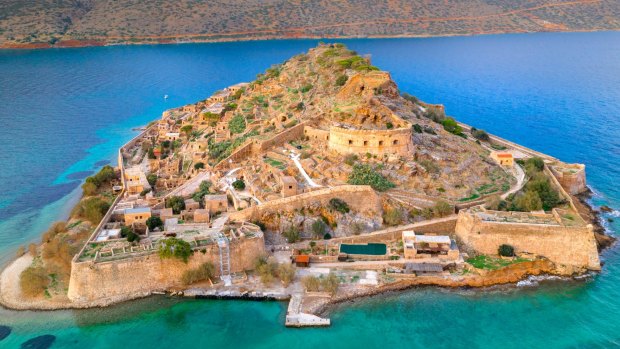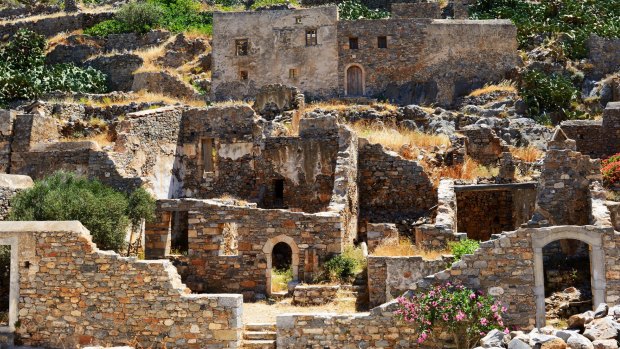This was published 4 years ago
Greece's Spinalonga might just be the strangest ruin in the Mediterranean
By Brian Johnston

An aerial view of the island of Spinalonga in Crete, Greece.Credit: iStock
A tourist cliche unfolds as we chug our way out to the tiny island of Spinalonga on a white-painted wooden fishing boat. The captain has gnarly fingers and a sun-beaten face. Cubist houses tumble down rocky brown hills overlooked by blue peaks. The bay shimmers in kingfisher colours, and the southern Greek sun is a hot caress.
On a predictable cruise excursion, we'd be heading to a chic beach retreat, a meet-the-locals farm or an ancient ruin. But I'm tempted with something different as we arrive aboard Azamara Pursuit in the port of Agios Nikolaos in Crete. Spinalonga isn't exactly your typical tourist sight, no matter its romantic setting. True, it's an island, but a rather foreboding one. True, it has ruins, but not the ones decorated with pretty pillars and statues of goddesses that you're usually shown in Greece.
The tiny island is wedged into the throat of a deep bay that could swallow an entire naval fleet. We disembark beneath a sinister bastion, part of the 16th-century Venetian fortifications that served to protect the natural port. So far so normal in the eastern Mediterranean, which is scattered with Venetian leftovers.

Buildings on the island.Credit: iStock
In 1904, though, someone with a twisted mind looked at this island fort and decided it would make the ideal prison for lepers. For a half century, lepers from across Greece were sent to Spinalonga. At times, nearly 400 people were cast away on this almost-barren islet, separated from their families and left to rot behind the crumbling ramparts and watchtowers of another era.
It's a grim tale well recounted by our local Azamara guide, Stavroula. We penetrate the bastions through a dark tunnel that leads us to the leper colony within. We see the incinerator used for burning leper clothing, and the cemetery, and the sea-lapped platform beyond the fort walls where supplies were hurriedly landed.
It would all be appalling if it weren't for the resilient nature of human endurance and hope. Against the odds, the lepers banded together and created a life. They ran a cafe, a few shops, a small school. They made the most of their crumbling Venetian- and Ottoman-era homes, planting climbing roses against their walls and painting shutters bright green and yellow. The colours are oddly out of place, yet jaunty and uplifting in this bleak brown place.
By 1938, the lepers had successfully petitioned the government to have part of the fortifications torn down so they were no longer pinned behind high walls, but could take a walk around the island and not feel caged. Even today the 20-minute circumnavigation feels like an escape into bright sunlight and sea breezes. On the seaward side, Spinalonga rises to small cliffs the flanks of which are peppered with hardly wildflowers and tortured fig trees.
A cure for leprosy was developed in the 1940s but, astonishingly, Greece just kept shippings its lepers to Spinalonga until the island was finally shut down amid a public outcry in 1957. Stavroula says that for years afterwards nobody dared visit. Only in the 1980s did local fishermen begin ferrying a few visitors to the former leper colony. In 2005, Victoria Hislop's bestselling novel The Island brought Spinalonga to wider attention.
Now boatloads arrive, but this remains quite a head-spinning destination in a country more associated with islands of whitewashed villages, hedonistic beaches and ruins far more ancient. Kudos to Azamara for bringing cruise guests here and telling the story. Spinalonga is a haunting place of gaping roofs and empty windows. The Mediterranean is a blue promise beyond its encircling walls, but its holiday glitter doesn't banish the melancholy atmosphere of this most peculiar tourist sight.
THE DETAILS
MORE
CRUISE
Azamara's 10-night Greece Intensive Voyage between Piraeus (Athens) and Venice, departing August 1, 2020, visits Agios Nikolaos in Crete, from which a shore excursion takes you to Spinalonga. The 3.5-hour shore excursion costs $US99. The cruise also visits Mykonos, Paros, Rhodes, Chania, Zakynthos and Corfu. Prices from US$3142 a person, twin share. Phone 1800 754 500. See azamara.com
Brian Johnston travelled as a guest of Azamara.
Sign up for the Traveller Deals newsletter
Get exclusive travel deals delivered straight to your inbox. Sign up now.